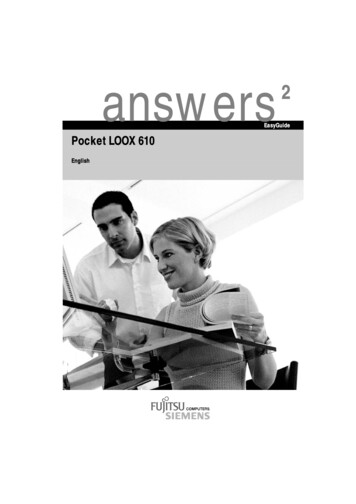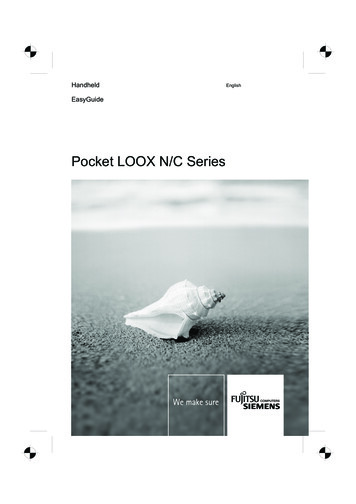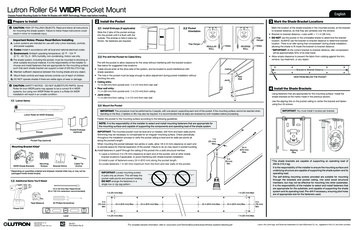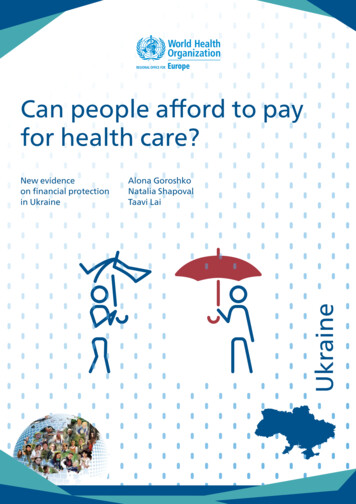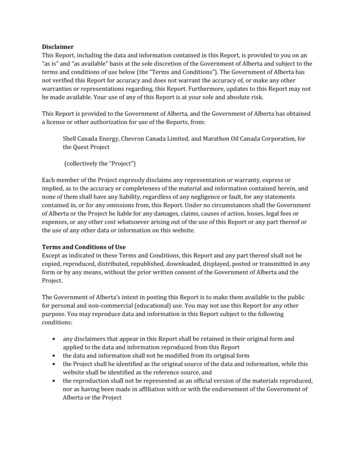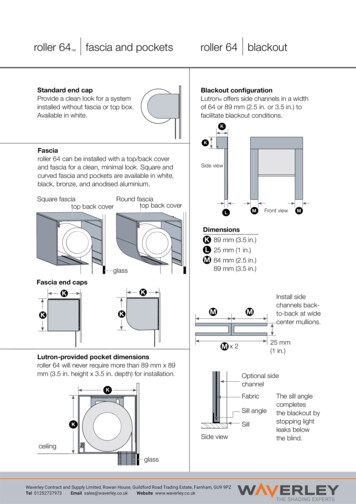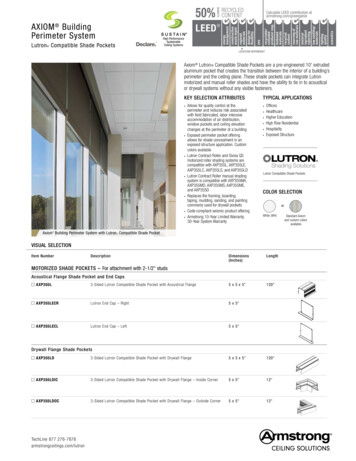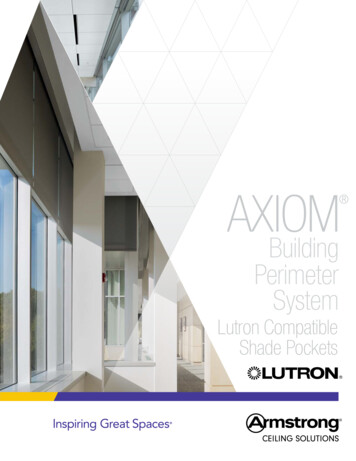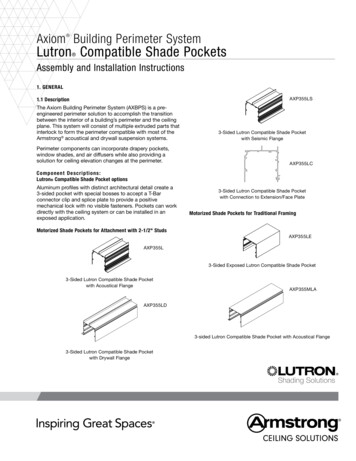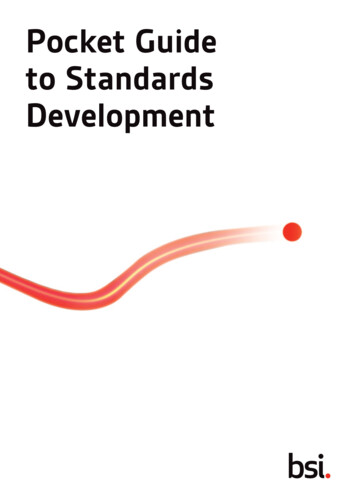
Transcription
Pocket Guideto StandardsDevelopment
Pocket Guide toStandards DevelopmentA large print PDF is available on request from yourCommittee Secretary or CSC.
First published in the UK in 2012byBSI Standards Limited389 Chiswick High RoadLondon W4 4AL The British Standards Institution 2012All rights reserved. Except as permitted under the Copyright, Designsand Patents Act 1988, no part of this publication may be reproduced,stored in a retrieval system or transmitted in any form or by anymeans – electronic, photocopying, recording or otherwise – withoutprior permission in writing from the publisher.Whilst every care has been taken in developing and compiling thispublication, BSI accepts no liability for any loss or damage caused,arising directly or indirectly in connection with reliance on its contentsexcept to the extent that such liability may not be excluded in law.While every effort has been made to trace all copyright holders, anyoneclaiming copyright should get in touch with the BSI at the above address.BSI has no responsibility for the persistence or accuracy of URLs forexternal or third-party internet websites referred to in this book, anddoes not guarantee that any content on such websites is, or will remain,accurate or appropriate.Typeset in BSI Gesta by HeliusPrinted in Great Britain by Berforts Group, www.berforts.co.uk
IntroductionIntroductionWelcome to BSI and Standards development. Getting to grips withbeing a member of a BSI committee and the process involved inmaking Standards is a lot of work and we’re here to give you thesupport you need.We’ve put together this introductory guidance material on thesituations and tasks that you’re likely to encounter when you first joina committee. This Pocket Guide is intended to cover the basics and toget you started.More support is available via the free training courses offered by BSIand we encourage you to take advantage of these. The course datesare published on the BSI website. You can also get more advice fromyour Committee Secretary or the Committee Service Centre.iii
ContentsWhat is a Standard?2What is the role of a Committee Member?4I represent a nominating organization. What does that mean? 8What is consensus?9How do I comment on documents?10Figure 2 Stages of Standards development, publication andmaintenance 14What is the development process for European and InternationalStandards? 15What should I expect from taking part in internationalmeetings? 22What is the development process for Standards of UK origin? 25Glossary291
What is a Standard?A Standard is an agreed, repeatable way of doing something. It’s apublished document that contains a technical specification or otherprecise criteria designed to be used consistently as a rule, guideline,or definition. Standards help to make life simpler and to increase thereliability and the effectiveness of the many goods and services thatwe use.Examples of real societal benefits provided by Standards include: helping businesses to secure and protect customer dataensuring energy bills are clear and easy to understandsafeguarding children while they’re on the internethelping hospitals to stay open throughout severe weatherconditionshelping the service industry to identify and respond to vulnerablecustomersenabling businesses to continue operating after a major disasteror weather disruptionensuring safety in toys, household electrical appliances, lightingetc.Credit and debit cards are another great example. Standardsfacilitate data exchange so that the cash machine of one bankcan read the card of another bank.2
What is a Standard?Global research carried out on organizations that are certified to anenvironmental management system Standard revealed that of theorganizations that took part in the survey: 77% believed that being certified to the Standard helped toimprove their corporate reputation78% had found it improved their compliance with legislation65% had identified cost savings.Source: BSI Business Benefits Survey 2011 –global clients certified to ISO 14001 (07/10/11)The British Standards Institution acts as the NSB (National StandardsBody) for the UK and is one of the world’s leading developers ofStandards. Eight out of ten of the most used and implementedStandards worldwide are Standards of UK origin – such as ISO 9001Quality management systems — Requirements, which was based onthe BS 5750 series Quality systems, first published in 1979.We develop Standards in committees that are made up ofmanufacturers, users, research organizations, governmentdepartments and consumers who all work together to addressindustry challenges. Over 9,000 UK experts volunteer theirknowledge and time to participate in BSI committees and contributeto the drafting of Standards. All new or revised Standards aremade available for public comment, via BSI’s Draft Review System,allowing input from any member of the general public who hasan interest in the content of the Standard.3
Standards are voluntary and can be verified within organizationseither by self-declaration or independent verification. Standards arenot regulatory or imposed by government but can be used to helpsupport legislation or regulation.What is the role of aCommittee Member?Being a BSI Committee Member is a substantial undertaking and formany people it is in addition to full time employment.Getting startedThere are three things you’ll need to do right at the beginning toprepare yourself for the role:1. register for eCommittees to ensure you have access to allthe documents and can communicate with the rest of thecommittee if you haven’t got login details contactecommittee.support@bsigroup.com2. read BS 0, the guiding principles for Standards development,which you can find on eCommittees3. complete the eLearning modules that BSI provides as aninduction details of these will be sent to you when you join.4
What is the role of a Committee Member?Getting involvedYou are representing your nominating organization and contributingtheir view to the Standards development process. This is achieved by: reading documents circulated to the committeecirculating new work proposals and drafts to your nominatingorganization so they can commentsubmitting your nominating organization’s comments to theCommittee Secretaryattending meetings and participating in the consensus buildingprocess.It’s not unusual for the debates during the Standards developmentprocess to involve a robust and frank exchange of views. There areserious matters under discussion and people who volunteer to joinBSI committees do so because they believe the work is important.The debates will be positive and constructive if you bear in mind thefollowing points: everyone has the right to courteous and open minded treatmentand for their views to be considered and respectedany conflicts of interest should be declaredconfidentiality should be maintained BSI has a media contactpolicy.5
If you’re a co-opted or individual capacity member you will becontributing your personal expertise rather than representing astakeholder, but the principles for effective participation remainthe same.MeetingsNational committee meetings usually take place at the BSI offices inLondon where there are dedicated meeting rooms with wi-fi access.There is no set number of meetings per year as this depends oneach committee’s workload, but it could be between one and four.Meetings are led by a nominated Chairman and a record of themeeting is kept. Minutes are confidential.Face to face meetings are very effective, but we recognize that theycan take up a lot of time. Teleconferencing and webconferencing canbe used and much of the work can be accomplished by e-mail.Intellectual propertyBSI retains copyright on all work accepted for inclusion in a Standard.When attending a meeting you will be required to sign an attendancesheet which states that a member operates in accordance with BS0 (copyright assignment is detailed in the document). Any memberwishing to include content that is not their own must ensure theyhave permission for the copyright to be assigned to BSI beforehand.Examples of IPR to bring to the attention of your CommitteeSecretary or raise during a committee meeting are:6
What is the role of a Committee Member? if you are aware of a patent that applies to the Standard underdevelopment if you supply the committee with a drawing that you have takenfrom your company internal manual or another source thenyou have to ensure that your company or the other source areaware you are supplying the drawing and agree to the IPR beingreleased and used in the Standard.if you supply the committee with a drawing that you havedesigned yourself you will be releasing the IPR so it can be usedin the StandardThe benefitsParticipating in a BSI committee has its benefits. These include: influencing the content of Standards that will support economicgrowth, innovation, consumer protection and safety, bothnationally and internationally networking with peers in your industry and expanding your circleof contactsdeveloping your skills in communication, negotiation anddiplomacy as well as your technical expertise it’s greatprofessional development.Committee membership work is rewarding. Your expertise, sustainedeffort and judgment will help derive substantial benefits for the UKand for the people you represent. Thank you for participating.7
I represent a nominatingorganization. What doesthat mean?A nominating organization is usually a body that represents agroup of stakeholders. It could be a trade association, professionalinstitution, user group, or consumer organization.It’s important that close and effective liaison is maintained betweenCommittee Members and the organizations they represent. Weexpect that comprehensive briefings and reports will be routinelyexchanged and that nominating organizations will ensure that,directly or indirectly, those representing their interests areadequately resourced to do so.You can, and should, circulate documents to your nominatingorganization and seek their views on the Standards you’re workingon, so that you can represent those views to thenational committee.Complimentary StandardsOnce a Standard is published it will be made available toCommittee Members via eCommittees for two months. You cantake a complimentary copy for yourself and a single copy for yournominating organization.8
What is consensus?What is consensus?The principle of consensus has its origins in the desire to achieve thegeneral acceptance and application of a Standard within its intendedsphere of influence. This entails trying to ensure that the interests ofall those likely to be affected by it are taken into account, and thatindividual concerns are carefully and fairly balanced againstthe wider public interest.Achievement of consensus entails recognition of this wider interestand willingness to make reasonable compromises. Trivial or vexatiousobjections are unlikely to gain support and may be over-ruled.However, where a member consistently maintains a fundamentalobjection and supports it with sound arguments, these concernswill be taken seriously.If such objections are not voiced and sustained, normally within thecontext of a committee meeting where they can be put to the test,it will be assumed that consensus has been achieved.9
How do I commenton documents?Several types of document will be circulated for comment viaeCommittees. Committee Drafts and Drafts for Comment – CDs and DCs. Thesedocuments are early stage drafts and robust commenting at thispoint will result in a much stronger document. Drafts for Public Comment – DPC, ENQ (prEN), DIS, CDV. This isthe first formal vote on a document and is usually the point atwhich documents are made publically available for comment. Final Vote – FV (FprEN), FDIS. These documents are in their finalversion and the national committees vote on whether or not theyshould be published.If you represent a nominating organization, such as a tradeassociation or a professional institution you should gathercomments from that organization. You can share the document forcomment with them.Nominating organizations manage providing their representativeswith comments in various ways. There may be a committee whichyou report back to or you may be empowered to speak on theirbehalf. Once you’ve consulted with your nominating organizationyou can submit your comments to your BSI committee.Comments are submitted to BSI via the commenting form. A blanktemplate can be found in eCommittees. It’s advisable to download10
How do I comment on documents?the template from eCommittees each time you submit comments asthis will ensure you always have the latest version. A blank form isshown in Figure 1 on page 13.National committee (Col 1)In the first column, enter either your initials or the name of yournominating organization.Line number, Clause/subclause, Paragraph/Figure/Table (Cols 2 4)The next three columns help identify the particular part of theStandard you’re commenting on.Type of comment (Col 5)There are three types of comments:1. General – general comments on the Standard as a whole orcomments that are neither technical nor editorial2. Technical – comments on the technical content of the Standard3. Editorial – purely editorial comments such as corrections tospelling or rewording to express the technical point more clearly.Comments (Col 6)Make your comments in this column.Proposed changes (Col 7)It helps to clarify your comment if you can make a suggestion forimprovement. It’s also more likely to be accepted if a constructivealternative is provided.11
Observations of the secretariat (Col 7)Don’t fill in this column. It’s used by the international CommitteeSecretary to record the working group’s response to the submittedcomments.Document headerPut the document number here.Take care not to alter the column widths or merge cells in thecommenting table. Documents are submitted and collatedelectronically and changes to the column width interfere with thisprocess. It is possible that comments will not be accepted as a result.What happens once I’ve submitted comments?The deadline given by BSI allows time for discussion of all thecomments submitted by members of the committee before theyare submitted to the European or international committee.All the comments are collated by the Committee Secretary andare circulated to the committee for discussion. If there are a lotof comments, or there is disagreement between members of thecommittee, a meeting or teleconference may be called to resolvewhich comments will go forward.When the comments are minor, or all members are in agreement,the discussion can take place by email.Once the UK national position has been agreed by the committee,by consensus, it will be submitted to the European or internationalcommittee. The comments from each of the national memberbodies will be considered and the results will be made available viaeCommittees.12
13NationalcommitteeLinenumberDocument Project Nr.Figure 1 – Comments templateTechnical/Editorial)on each commentsubmittedClause/ Paragraph Type of COMMENTS Proposed OBSERVATIONSSubclause Figure/commentchangeOF THETable(General/SECRETARIATDate
New work (5.2)Internationalstandardization (5.3)Europeanstandardization (5.4)UKstandardization (5.7)Drafting and consensus building (5.5 and 5.7)Consultation – Draft for public comment (5.8)Development of final text (5.5.4 and 5.7)Adoption (6.1.2)Approval of publication (6.1.4)Publication (6.1)Maintenance (6.2)The numbers in the flow chart relate to subclauses in BS 0.Figure 2 – Stages of Standards development, publication andmaintenanceSource – BS 0:201114
What is the development process forEuropean and International Standards?What is the developmentprocess for European andInternational Standards?While the names of stages in the process of development differacross the European and International Standards organizations(ISO, IEC, CEN, CENELEC, see Table 1 on pages 20 and 21), allStandards go through the same development process.i) New work proposal or revisionEach project to revise or amend an existing document, or to developa new Standard, has to go through an acceptance process to ensurethe work is necessary and that the resources are in place to carryout the work. Each national member body will vote on the proposal.BSI committees agree their vote at a committee meeting or viacorrespondence.(i) BSI committee input: Voting and comment, andappointment of experts.15
ii) Preparation (drafting)Once a project has been accepted the core work in developingthe Standard begins. This often takes place in a working group,also called a project team or maintenance team, which consists ofexperts in the subject nominated by national member bodies whowork together to develop a draft.(ii) BSI committee input: Your BSI committee mayappoint you as an expert to provide specialistknowledge and experience to the working group.iii) Committee stageWhen the working group is satisfied that the draft is ready for widerreview it is circulated to the national members for comment and/orvote. During the committee stage a project may go through severaldrafts.(iii) BSI committee input: Comment on the draft.16
What is the development process forEuropean and International Standards?iv) Public consultationIf the draft is approved at the committee stage, it is then madeavailable for public consultation.(iv) BSI committee input: In the UK a Draft forPublic Comment (DPC) is made available for twoto three months. BSI circulates the DPC to theBSI technical committees that have an interestin the work. The DPC is also made freely availableto the public via our online Draft Review System.As a Committee Member you will ensure yournominating organization is aware of the DPC andwill feed its comments back to the BSI committee.v) Comment resolutionAfter public consultation, national member bodies send theircomments to the working group. The working group decides whetherto accept the comments, editorial, technical or general, and modifiesthe draft accordingly. Once the comments have been resolved, theupdated draft is circulated to countries for vote, together with adocument showing the decisions made during the resolution of17
comments. If there is significant technical change to the draft it maybe sent for a second consultation period. If the draft passes the voteit proceeds to the approval stage.(v) BSI committee input: At the end of the UKconsultation period all the comments are collatedand distributed to the BSI committee. You willparticipate in the process of deciding which of thepublic comments are forwarded to support theUK response to the consultation.vi) Approval stageThe draft is submitted to the national member bodies for approval,by vote, to publish the Standard.(vi) BSI committee input: Voting and editorialcomments only.18
What is the development process forEuropean and International Standards?vii) PublicationFollowing successful formal approval the Standard may beimplemented as a British Standard, at which point any conflictingnational Standards are withdrawn. This is a requirement forEuropean Standards and optional for International Standards. Anyinformation that the committee believes will support the use ofan adopted Standard in the UK may be published in the NationalForeword or as a National Annex.viii) ReviewTo ensure a Standard is current and needed it is periodicallyreviewed. The review considers whether the Standard shouldbe retained, amended, withdrawn, or revised.19
20Preparation(drafting)CommitteestageNew WorkProposalCENIECCLCBSIcommitteeinputVoting andcommentingNew workapproved byresolutionNWIPNew workapproved byresolutionNWINew workproposal (NP)RevisionReport (RR)New WorkProposalsubmittedto TechnicalBoard.(IEC parallelprojectsestablishedat CDV stage.)Development by working group, project team orInput frommaintenance teamUK ingDraft (CD)Draft (WD)Draft (CD)EnquiryISOTable 1 European and International Standards – development process
CommitteeCLC Enquiry Voting andcommentingDraft for Vote (ENQ)(CDV)orIEC CDVparallel vote.Final DraftFormal Vote Final DraftFormal Vote VotingInternational (FV)International (FV)StandardStandardor(FDIS)(FDIS)IEC FDISparallel vote.PublicationReviewApprovalstagePublicDraftCEN Enquiryconsultation International (ENQ)Standard(DIS)What is the development process forEuropean and International Standards?21
What should I expect from takingpart in international meetings?One of the most important aspects of being a BSI CommitteeMember is communication. This means acting as a link between thecommittee and the organization you represent, putting forward theirviews to the committee and making sure your colleagues in industryare aware of the activities of the committee.Communication is also crucial when taking part in internationalmeetings, whether in Europe at CEN and CENELEC or globally atISO and IEC. You will need to know the UK position, arrived at byconsensus in the committee meeting, so that you can represent BSIand then report to the UK committee on the outcomes ofthe meeting.Before the meetingDepending on the type of meeting you are attending, you will begoing as either a delegate (part of the UK national delegation) or as anominated UK expert.DelegatesWhen international technical committees or subcommittees meetthe national member bodies send a delegation. As a member of adelegation attending a meeting you will representBSI and present the agreed UK view. You will be expected to putaside your personal, commercial or nominating organization’s views22
What should I expect from takingpart in international meetings?in order to present the UK position. As a delegate you are elected forone meeting at a time.The delegation that will attend an international meeting is usuallyselected at a meeting of the UK committee that is responsiblefor following the work of the international committee. During thismeeting the agenda for the upcoming meeting of the internationalcommittee will be discussed and a UK opinion will be agreed. Theseagreed actions will form the brief to the UK delegation, instructingdelegates how to vote where votes are to be taken, and givingguidance as necessary on other agenda items.As a delegate you need to be confident that you can present the UKview, sometimes in areas where your technical knowledge may belimited.ExpertsWhen working groups are established to work on specific projectsthe national members nominate experts. These working groupsmay also be called project teams or maintenance teams. Expertsare nominated for their personal expertise. You are a member ofthe group and will be expected to provide input based on yourown experience and knowledge. You will need to be aware of anyestablished UK view regarding the projects, and while you areunder no obligation to represent it, there will be times when it isappropriate to do so.Working group meetings tend to concentrate on the Standards theyare developing. In between meetings, a lot of work can be achievedvia email or teleconference. As an expert on the working group youwill need to have a clear view on the technical content of papers23
circulated before the meeting, noting that it may be necessary todiscuss it with your UK committee colleagues.After the meetingWhether you attend a meeting as a delegate or as an expert you willbe expected to provide timely reports back to the UK committee.These reports should concentrate on the major points of discussionson the agenda items, significant decisions, and anything of particularinterest to the UK.It won't be necessary to provide a verbatim report of discussions,but your report should give an account on how the meeting wentfor the UK. You should not rely on the international CommitteeSecretary’s official meeting report as this often has a different focus;for example, a document may have half an hour of robust discussionbut no decision is made and the international Committee Secretarycould report just that. Your report should give more detail on wherethe items under discussion could impact on the UK, which countrieswere making particular points, etc.As soon as possible after the meeting you should provide a report foryour colleagues on the UK committee. If more than one UK delegateattends, one of them will be appointed as reporter. While there is nofixed format for this report it is good practice to include at least thefollowing points: 24number and title of the committee meeting that was attendeddate(s) of meetinglocation of meeting (usually the city/town and the country)
What is the development processfor Standards of UK origin? author of the report date and venue for the next meeting.names and affiliations of other UK attendeeslist of the other countries attending and number of delegates/expertsany additional papers circulated at the meetingany items added to the agenda of the meetinglist of items that were discussed with your view on how theywent for the UK with particular emphasis on those items thatare of specific interest to the UKYour report should enable the UK committee to understand themood of the meeting together with the strength of support for,or opposition to, UK views.What is the development processfor Standards of UK origin?ProposalA proposal for new work is submitted to BSI. Anyone can submit aproposal, whether it is from a member of the committee, a tradeassociation or a member of the public via the Draft Review System.25
Project acceptanceA business case is prepared by the committee in conjunction withthe Committee Secretary. This is submitted to a BSI acceptanceteam for consideration. If the project is accepted by BSI a contentdeveloper is assigned to the project.DraftingDrafting is generally carried out by a small panel of experts, togetherwith the content developer. Several versions of thedraft might be produced before it is finalized.Approval for public commentThe draft is circulated to the panel and its parent committee(s) forapproval. Two weeks is generally allowed for this. Then the projectproceeds to the next stage which is to seek public comment.Public consultationThe public comment period of two months enables a broaderaudience to view the draft. This contributes to making the Standardsdevelopment process transparent and helps make the resultingStandard acceptable to all stakeholders. Comments on all drafts canbe made, by any interested party, through the online Draft ReviewSystem.26
What is the development processfor Standards of UK origin?Comment resolutionThe comments received during the public comment period areconsidered by the panel, with input from the content developer. Thedraft is amended in line with the decisions taken.Final approvalA final draft is prepared by the content developer which is circulatedto the panel and its parent committee(s) for a two week approvalperiod. Consensus needs to be achieved by the relevant parentcommittee before the Standard can be signedoff for publication.Endorsement to publishThe Committee Secretary and Chairman of the relevant technicaland/or subcommittee endorse the draft for publication. Afterthis, there is generally no further involvement from the panel orcommittee(s) prior to publication.TypesettingThe content developer submits the draft-for-publication manuscriptto the BSI production team for typesetting.27
PublicationThe Standard is published and details of the new publication aremade available on the BSI Shop and through Update Standards andBSI subscription products (BSI Plus and BSOL). BSI aims to publishnew/revised British Standards, Drafts for Development and NationalAnnexes within 12 to 15 months. Published Documents take around 9months and amendments 6 to 12 months.ReviewStandards are reviewed every five years to ensure their continuingaccuracy.28
GlossaryGlossaryCommon abbreviations, acronyms and termsAHG Ad hoc groupAMD AmendmentRatified supplementary document to a Standard that has alreadybeen circulated to national members for national implementation,to be read in conjunction with that Standard and which alters and/oradds to previously agreed technical provisions.Annex ZEuropean annex(es), both normative and informative, on normativereferences to international publications with their correspondingEuropean publications, special national conditions, a-deviations and,in case of candidate harmonized Standards, the relationship withessential requirements of New Approach Directive(s).BS British StandardPublished UK national Standard, may have either been developedsolely for use in the UK or may adopt a European (EN) orInternational (ISO/IEC) Standard.BT (CEN/CLC) Bureau Technique (Technical Board)Technical board established in both CEN and CENELEC to overseethe work programme of each organization.CD Committee DraftDrafting stage in the development of ISO and IEC Standards.29
CDV Committee Draft for VoteStage in the development of IEC Standards, equivalent to ENQ or DIS,in which a draft is made available for an extended comment period,and which attracts a vote from each P-member.CEN Comité Européen de NormalisationEuropean Standards bodyCENELEC (CLC) Comité Européen de Normalisation ElectrotechniqueEuropean body for electrotechnical standardizationCMC CEN Management CentreAdministrative offices of CEN/CENELECCOR CorrigendumSupplementary document which corrects one or more errors orambiguities that were inadvertently introduced in either draftingor printing and which could lead to incorrect or unsafe applicationof the Standard.CWA CEN Workshop AgreementCEN/CENELEC agreement, developed by a workshop, which reflectsthe limited consensus of identified individuals and organizationsresponsible for its contents.DC Draft for CommentUsed in CENELEC and IEC.DIS Draft International StandardStage in the development of an ISO Standard, equivalent to E
65% had identified cost savings. Source: BSI Business Benefits Survey 2011 - global clients certified to ISO 14001 (07/10/11) The British Standards Institution acts as the NSB (National Standards Body) for the UK and is one of the world's leading developers of Standards. Eight out of ten of the most used and implemented
